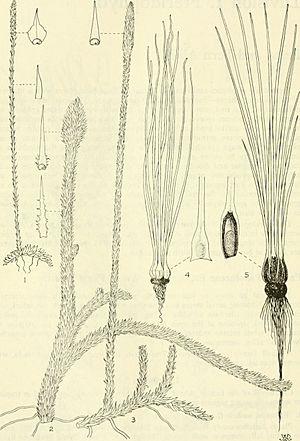Isoetes melanopoda facts for kids
Quick facts for kids Isoetes melanopoda |
|
|---|---|
 |
|
| Scientific classification | |
| Genus: |
Isoetes
|
| Species: |
melanopoda
|
| Synonyms | |
|
|
Isoetes melanopoda is a unique plant. It's a type of plant that doesn't grow flowers. Instead, it's part of a group called quillworts. People often call it the black-footed quillwort, midland quillwort, or prairie quillwort because of how it looks and where it lives.
Contents
What is the Black-Footed Quillwort?
The black-footed quillwort is a plant that looks a lot like grass. It can grow up to about 40 centimeters (16 inches) tall. This plant is a perennial, meaning it can live for more than two years. However, sometimes it doesn't live very long.
Its bright green leaves are long and thin, like quills or blades of grass. The bottom part of these leaves is usually black. This is where the name "black-footed" comes from! The leaves are also deciduous, which means they fall off after a certain time, similar to how some trees lose their leaves in autumn.
How Does it Reproduce?
Unlike flowering plants, the black-footed quillwort reproduces using spores. Each mature leaf has a special part called a sporangium. This sporangium produces two different kinds of spores:
- Microspores: These are like tiny male spores.
- Megaspores: These are larger female spores.
This way of reproducing, using two different types of spores, is called heterospory. It's a cool way for plants to make new plants without needing flowers or seeds!
Where Does the Quillwort Live?
The black-footed quillwort lives in different parts of the United States. You can find it in the Midwest, Eastern, and Southern states. However, it's not found everywhere in these areas. Its populations are often spread out, meaning there are big gaps between where different groups of these plants grow.
Special Places for Growth
This plant often grows in very specific and uncommon places. These special spots are called microhabitats. For example, in Minnesota, it lives on the southwestern edge of the state. Here, it grows in shallow pools of water that slowly drain from layers of a rock called Sioux quartzite.
You might also find these plants growing on rocky outcrops. These are places where rocks stick out of the ground. The quillworts grow in small pockets of soil on these rocks, or at the edges of pools where soil has gathered.
Is it an Endangered Species?
Yes, the black-footed quillwort is considered an endangered species in several states. This means there aren't many of these plants left, and they are at risk of disappearing forever if we don't protect them.
It is listed as endangered in:
- Minnesota
- Indiana
- Iowa
- Kentucky
- New Jersey
- Tennessee
Protecting these unique plants and their special habitats is important to make sure they can continue to grow for many years to come!

